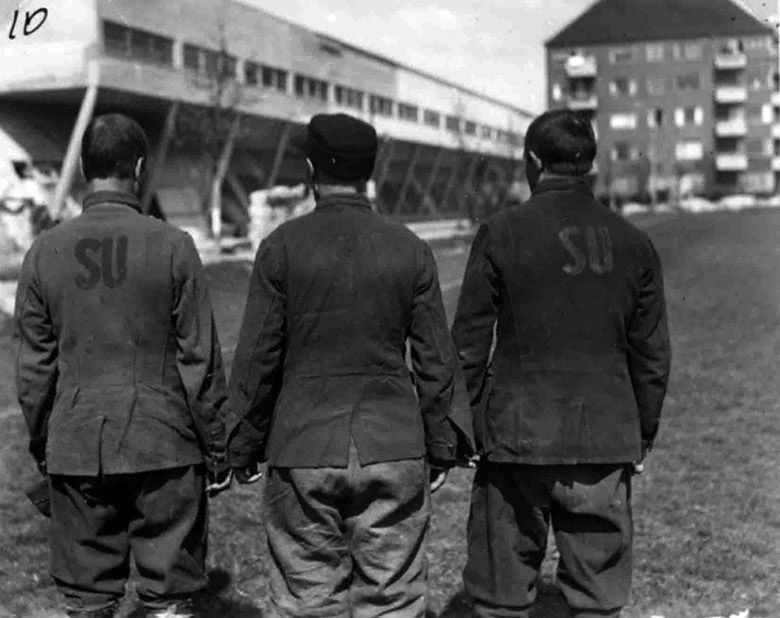German intelligence general, Erwin von Lahousen, testified against the defendants, many of whom were directly or indirectly responsible for the massacre of Soviet prisoners of war. All the facts he presented confirmed that the Germans had deliberately violated the Geneva Convention relating to the Treatment of Prisoners of War, ratified by Germany in 1934.
Executions
Lahousen: “These orders dealt with two groups of measures which were to be taken. First, the killing of Russian commissars, and secondly, the killing of all those elements among the Russian prisoners of war who, under a special selection programme, could be identified as thoroughly bolshevized or as active representatives of the Bolshevist ideology. (…) these orders were carried out – according to my recollection – by the Einsatzkommandos (mobile killing squads) of the Sicherheitsdienst (security services, aka SD). These SD squads were in charge of both singling out persons in camps and in assembly centres for prisoners of war, and of carrying out the executions.”
Article 2 of the Geneva Convention relative to the Treatment of Prisoners of War regulates that “measures of reprisal against prisoners of war are forbidden”.
Article 47 of the Geneva Convention relative to the Treatment of Prisoners of War states that prisoners of war “in cases of acts constituting a breach of discipline, and particularly an attempt to escape, shall be drawn up in writing without delay”, which means that they are subject to legal proceedings.
Segregation
Lahousen: “Reinecke (General Hermann Reinecke, the chief of the prisoner-of-war department of the High Command) was of the opinion that in the camps their treatment (the treatment of Russian prisoners of war in the camps) must not be the same as the treatment of other allied prisoners of war, but that here, too, appropriate and discriminating measures must be applied. The camp guards, at all events, had to be furnished with whips, and at the slightest sign of an attempted escape or other undesirable act, the guards should have the right to resort to arms”.
Article 46 of the Geneva Convention relative to the Treatment of Prisoners of War regulates that “All forms of corporal punishment, confinement in premises not lighted by daylight and, in general, all forms of cruelty whatsoever are prohibited”.
Unbearable Conditions
Lahousen: “The enormous crowds of prisoners of war remained in the theatre of operation, without proper care – care in the sense of prisoner-of-war conventions – with regard to housing, food and medical care; and many of them died on the bare floor. Epidemics broke out, and cannibalism – human beings driven by hunger to devour one another – manifested itself.”
According to Article 7 of the Geneva Convention relative to the Treatment of Prisoners of War, “as soon as possible after their capture, prisoners of war shall be evacuated to depots sufficiently removed from the fighting zone for them to be out of danger”.
Article 10 of the Geneva Convention regulates that “Prisoners of war shall be lodged in buildings or huts which afford all possible safeguards as regards hygiene and salubrity”.
Article 11 of the Geneva Convention regulates that “the food ration of prisoners of war shall be equivalent in quantity and quality to that of the depot troops”.
NUMBERS
The German Directive of 8 October 1941 on the “Food Ration for Soviet Prisoners of War” stipulated that Soviet prisoners of war should be provided with half as much food as prisoners from other countries.
The directive established the monthly ration (for 28 days) of food supply for the Soviet prisoners of war as a percentage of the food standard for prisoners from other countries:
For prisoners doing special work:
Bread, 9 kilograms – 100%;
meat, 800 grams – 50%;
fat, 250 grams – 50%;
sugar, 900 grams, – 100%.
For prisoners of war not employed on essential work:
Bread, 6 kilograms – 100%;
meat, 0 grams;
fat, 440 grams – 42%;
sugar, 600 grams, – 66%.
Quotes:
“Political commissars in their capacity of officials attached to the enemy troops are recognisable by their special insignia – red star with a woven golden hammer and sickle on the sleeves – […]. They are to be segregated at once - ie, while still on the battlefield - from the prisoners of war. This is necessary in order to deprive them of any possibility of influencing the captured soldiers. Those commissars will not be recognised as soldiers; the protection granted to prisoners of war in accordance with International Law will not apply to them. After having been segregated they are to be dealt with”.
The Directive for the Treatment of Political Commissars (The Commissar Order) issued by the German High Command (OKW) on 6 June 1941.
“(…) The feeling of pride and superiority of the German soldier ordered to guard Soviet POWs, must at all times be visible even in public. (…) Insubordination, active or passive resistance must immediately be broken completely by force of arms (bayonets, butts and firearms)”.
Regulation for the treatment of Soviet POWs in all prisoner-of-war camps issued by the German High Command (OKW), dated 8 September 1941.
























